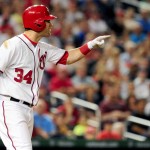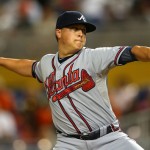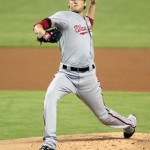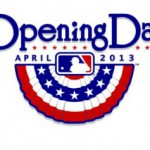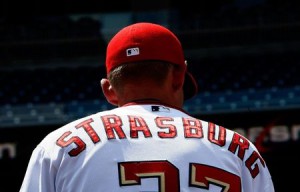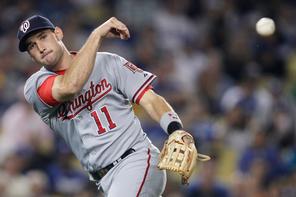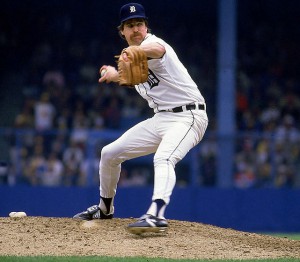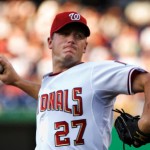
Loved Zimmermann’s 1-hitter last week. Photo AP/Manuel Balce Ceneta
We havn’t done an Ask Tom Boswell chat response in a while; I started one from last week’s chat but ended up deleting it. Nothing really to add to what Boswell was responding.
Here’s the 4/29/13 edition, after an up and down week with the Nats; getting swept by St. Louis and then taking three of four from Cincinnati behind some of the best starting pitching we’ve seen in a while.
As always, I’ll write a response here before reading Boswell’s, and will edit questions for clarity.
Q: Did Strasburg learn anything from watching Gio’s and JZimm’s efficient starts against the Reds?
A: We talked a bit about Stephen Strasburg‘s issues last week in this space. I’m not sure what he could have learned from Gio Gonzalez and Jordan Zimmermann‘s consecutive 1-hit outings that he didn’t already know; get ahead of hitters, throw first-pitch strikes, use your whole arsenal. Cincinnati is a good hitting team, but Atlanta is better. At least we have the distinct pitching matchup advantage in game one (when the struggling Julio Teheran goes for Atlanta). Boswell repeats both my points here; first pitch strikes and a favorable Teheran matchup.
Q: Why is blocking the plate by the Catcher now suddenly such an issue?
A: I think it starts with the horrible injury suffered by Buster Posey; a needless debilitating injury that took out an MVP candidate and cost him a year off his career. Locally, we all remember Chase Utley‘s cheap shot on Jesus Flores, which essentially cost him two years and a job in the majors. And I think it is the general climate in sports today to try to avoid concussive injuries at all costs in the wake of the very scary CTE studies that are out there and may change the very fabric of Football as we know it. Every time there’s another injury, another collision the drumbeat gets louder. Just because catcher collisions have always been a part of the game doesn’t mean they’re right. I’m in favor of eliminating the play, and If I was a MLB manager i’d advise my catchers to give the runner half the plate and try to avoid injury. Boswell agrees.
Q: Why isn’t Solano catching any games?
A: Two reasons: Kurt Suzuki by virtue of the off/on schedule with Wilson Ramos for the first couple of weeks is relatively rested and can catch 6 straight days. The other? Jhonatan Solano just isn’t as good of an offensive option, and with the whole team struggling at the plate why put a guy in who is clearly overmatched? The guy only has about 100ABs above AA after all. Boswell says the last thing you should do when struggling is bench a veteran for a rookie, especially at catcher. Ramos returns from the DL tonight so its a moot point.
Q: If you were betting on a team to win the next World Championship in DC who would be that team?
A: You have to think its the Nats right? Redskins are lookup up with RGIII but aren’t a complete team yet and may be a couple years off (and no more salary cap penalties) from putting together a SB team. The Wizards may not be relevant for another decade. The Caps are hot and may go for a decent run in the NHL playoffs, but those series are such coin flips that if they couldn’t win when they were the league’s best regular season team, its hard to see why they’d win now. Lastly DC United is just getting back to some respectability after years of decline, but winning an MLS title over some of the powerhouses in the league is a tall order. Boswell says Nats, Caps, Skins. Doesn’t even mention the other two franchises 🙂
Q: Any chance Bud steps in ala with the Dodgers and Frank McCourt and forces Loria’s to sell the team?
A: I think there’s a chance, but something “illegal” would have to happen. Selig was able to force McCourt to sell when the league was being embarassed and the team was clearly suffering financially because of mis-management. Selig has allowed Loria to already do several unsavory things to fan bases in both Montreal and Miami, so its hard to see what else could happen. However, if this supposed SEC investigation finds real evidence of fraud and the team is sued, I can see Selig stepping in and forcing Loria out. Boswell doesn’t really answer the question.
Q: When he gets sent down next week, would you be surprised if he played second base exclusively given that Espinosa is now struggling with the bat and glove?
A: Anthony Rendon was ALREADY playing multiple positions in the minors this season, starting mostly at 3B but also getting a few games at 2B and at least one at SS. But I don’t think Rendon would be Danny Espinosa‘s replacement; Steve Lombardozzi would be. If Espinosa were to be sent to the DL, Lombardozzi starts and then Rendon probably gets called back up to provide some infield cover. Boswell thinks Rendon could make the transition, but needs more minor league time. He also talks a lot about Espinosa vs Lombardozzi and (in my opinion) overrates the defensive value of Espinosa a bit. In the age of rising strikeouts, it isn’t as important to have Gold Glove calibre fielders everywhere. This is just a partial answer that may need eventual expansion in a blog post of its own.
Q: Mr. Boswell, why did Davey insert Rendon instead of Lombardozzi (following Ryan’s injury) into the lineup and why did he not allow Tyler Moore to start Sunday with Cingrani on the bump?
A: Good questions, both. I think the team likes Rendon’s defense at 3B more than Lombardozzi or Chad Tracy, so that makes sense at least against lefties. Why didn’t Tyler Moore play against the tough lefty Tony Cingrani? I do not know. You could see Adam LaRoche‘s o-fer a mile away going against the second coming of Randy Johnson (Cingrani’s now has 37 Ks in 23 MLB innings). Perhaps veteran preference/veteran blind spot on the part of Davey Johnson? Boswell agrees at least with the LaRoche assessment.
Q: Have the Nats have over-managed Strasburg (in terms of pitch counts, innings limits and pitching to contact) since his injury and gotten into his head?
A: I don’t see Strasburg’s issues being a result of lack of confidence. If that was the case we’d be seeing 3ip-8 run explosions, not “first inning bad then lights out for the next 6 innings” outings. Have the Nats over-managed him? Perhaps; we know Strasburg didn’t like the 2012 shutdown but I supported it (as did the surgeon who performed the damn operation, nobody ever remembers). I think Strasburg also understands the value of getting hitters to hit your pitch instead of going for blow-em-away Ks every time. Call it “pitch to contact” but I like to call it “making them hit your pitch.” You want to try to get a great swing in after falling behind in the count? Fine; hit my 97mph inside fastball for power, or try to drive my 94mph sinking 2-seamer on the outside corner. I’ll tip my hat to you if you do.
But Strasburg misses his spots; his command has not been great. 97mph flat on the corner is good; in the middle of the plate is bad. He’s been missing in the middle way too much. Boswell defended his column, saying Strasburg needs to “keep it simple.”
Q: What does the team do with Henry Rodriguez?
A: So far this year we’re seeing nothing but “bad” Henry Rodriguez: more walks than hits, too many base-runners, and too many pitches that he just has no idea where they’re going. He only threw FOUR of Seventeen pitches yesterday for strikes. Luckily for him, its only a “wild pitch” if someone advances right? Because some of those pitches were just ridiculous. I’ll chalk it up to the wet conditions, as (likely) will management.
What can they do with him? As often repeated in this space, he’s a human roster logjam. The team has been forced to carry him and his Jeckyl and Hyde pitching for 3 years now because he was out of minor league options when we acquired him. We’ve invented nebulous DL trips to stash him in extended spring training. He’s now the lowest leverage guy on the bullpen, when he should be in the mix for 7th and 8th inning opportunities. But the thing is, there’s not really a guy in Syracuse who is beating down the door to come up. Maybe Erik Davis, who has pitched really well in AAA and has shown why the team put him on the 40-man. Or perhaps the team could call up one of its veteran lefties (Fernando Abad or JC Romero) in a pinch. But I think we’ll see at least another month of H-Rod trying to find his way before that happens.
Boswell raves about his career BAA (.211). To that I say this: he has now for his career walked 91 batters out of 606 plate appearances. That’s 15%. 6.1 bb/9. I’m sorry, but how can you have a reliever with those kind of walk rates be put into any close game? You can’t. So in my opinion there’s better ways to use the 7th bullpen slot.
Q: What’s a good ratio for balls to strikes?
A: I’ve always used 60% strikes to pitches thrown as a benchmark for a good outing. In Jordan Zimmermann‘s 1-hitter he threw 59 of 91 for strikes, or 64%. In Yu Darvish‘s near perfect game in early April he threw 78 of 111 pitches for strikes for 70%. Boswell says 65% is a good goal; honestly that’s a bit too high for me realistically.
Q: Do you think Soriano’s presence is helping or hurting Storen?
A: Good question. Drew Storen‘s struggles so far are really baffling; how do you go from a career 1.099 whip in your first 3 seasons to a 1.7 whip in 2013? And it isn’t on walks; he’s giving up a ton of hits. Perhaps it is mental; when Rafael Soriano himself has been a non-closer, his numbers have never been as good than when he’s getting the Saves. Perhaps Storen is struggling to adapt to this mindset so far. It also could just be small sample size syndrome too; its only April 29th after all. Boswell basically says that Storen isn’t a kid anymore and that he should “man up.”
Q: What are Harper’s MVP chances looking like right now?
A: Pretty good. MVP voting usually starts with “the best players on the best teams” and then whittles down from there. Bryce Harper is clearly the best hitter on what should be a playoff team, and has been making a game-wide name for himself so far with his performance. If Washington wins the division and Bryce keeps playing like this, he’s a shoe-in. However, some guy named Justin Upton has been just as strong; if Atlanta wins the division Upton may be the name people vote for.
